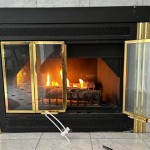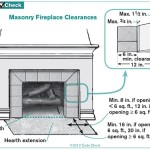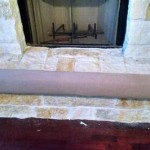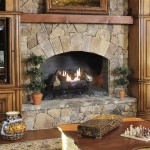Gas Fireplace Inserts Installation: A Comprehensive Guide
Gas fireplace inserts offer a convenient and efficient way to upgrade an existing wood-burning fireplace. These inserts slide into an existing fireplace opening, transforming it into a source of supplemental heat that is easier to operate and maintain than traditional wood-burning fireplaces. The installation process, while seemingly straightforward, requires careful planning, adherence to safety protocols, and often, professional expertise.
Understanding the scope of a gas fireplace insert installation is crucial before embarking on such a project. This includes assessing the existing fireplace, selecting the appropriate insert, and ensuring compliance with local building codes and regulations. Improper installation can lead to safety hazards, reduced efficiency, and potential structural damage. Therefore, a thorough understanding of the process is essential for a successful and safe installation.
Key Considerations Before Installation
Prior to installing a gas fireplace insert, a series of vital considerations must be addressed. These include assessing the existing fireplace's condition, determining the appropriate insert size and type, and verifying gas line compatibility. Failing to address these aspects can lead to inefficiencies, safety concerns, and project delays.
Chimney Inspection and Cleaning: The existing chimney must be thoroughly inspected by a qualified professional. The chimney is critical for venting exhaust gases produced by the gas fireplace insert. Cracks, deterioration, or blockages can impede draft and potentially cause dangerous carbon monoxide buildup. A professional inspection will identify any necessary repairs or cleaning required to ensure safe and efficient operation. Creosote buildup, common in wood-burning fireplaces, must be completely removed as it poses a significant fire hazard with gas appliances.
Fireplace Measurements and Insert Selection: Accurate measurements of the existing fireplace opening are crucial for selecting the correct size gas fireplace insert. The insert must fit snugly within the opening, allowing for proper sealing and efficient heat distribution. Consult the manufacturer's specifications to ensure compatibility and adequate clearance. Consider the desired heating capacity (BTUs) and aesthetic style when choosing an insert. Factors such as the size of the room to be heated and personal preferences regarding flame appearance should influence the selection process.
Gas Line Assessment and Modification: The existing gas line must be assessed to ensure it can adequately supply the gas pressure and volume required by the new insert. A qualified gas technician should inspect the gas line for leaks, proper sizing, and compatibility with the insert's specifications. If the existing gas line is inadequate, modifications or a new gas line installation may be necessary. This aspect of the installation is critical and should only be performed by a licensed professional to prevent gas leaks or explosions.
The Installation Process: A Step-by-Step Guide
The installation process involves several key steps, each requiring careful attention to detail and adherence to safety guidelines. This includes preparing the fireplace, installing the vent liner, connecting the gas line, and securing the insert within the fireplace opening. Each step must be performed correctly to ensure safe and efficient operation of the gas fireplace insert.
Fireplace Preparation: The existing fireplace must be thoroughly cleaned and prepared before installing the insert. Remove any remaining ashes, debris, or obstructions from the firebox. Inspect the firebox for any cracks or damage and make necessary repairs. A clean and structurally sound firebox provides a stable and safe foundation for the insert.
Vent Liner Installation: A flexible stainless steel vent liner is typically required to connect the gas fireplace insert to the existing chimney. The vent liner provides a dedicated pathway for exhaust gases and prevents condensation from damaging the chimney. The liner must be properly sized and installed according to the manufacturer's instructions and local building codes. Professional installation is highly recommended to ensure proper venting and prevent carbon monoxide hazards.
Gas Line Connection: Connecting the gas line to the insert is a critical step that must be performed by a licensed gas technician. Ensure the gas supply is turned off before connecting the gas line. Use appropriate fittings and sealant to prevent leaks. After connecting the gas line, perform a thorough leak test using a soap and water solution. Any leaks must be immediately addressed to prevent potential hazards.
Insert Placement and Securing: Carefully slide the gas fireplace insert into the prepared fireplace opening. Ensure the insert is level and properly aligned. Secure the insert according to the manufacturer's instructions, typically using screws or brackets. Proper placement and securing are essential for preventing the insert from shifting or dislodging during operation.
Safety Considerations and Post-Installation Checks
Safety is paramount during and after the installation of a gas fireplace insert. Thoroughly testing the unit and ensuring proper ventilation is crucial to prevent potential hazards. Carbon monoxide detection and awareness are vital for ongoing safety.
Leak Testing: After completing the installation, perform a comprehensive leak test of all gas line connections using a soap and water solution. Check for bubbles, which indicate a leak. Tighten any loose connections or replace faulty fittings. Address any leaks immediately to prevent gas buildup and potential explosions.
Ventilation Verification: Ensure the vent liner is properly connected and unobstructed. Verify that the chimney draft is adequate to remove exhaust gases effectively. A properly functioning ventilation system is essential for preventing carbon monoxide buildup in the home.
Carbon Monoxide Detection: Install carbon monoxide detectors in the vicinity of the fireplace and throughout the home. Test the detectors regularly to ensure they are functioning properly. Educate all household members about the dangers of carbon monoxide poisoning and the symptoms to watch for. Carbon monoxide is a colorless, odorless gas that can be deadly. Early detection is crucial for preventing serious health consequences.
Professional Inspection: Following the installation, arrange for a professional inspection by a qualified technician. This inspection will verify that the installation was performed correctly and that the gas fireplace insert is operating safely and efficiently. A professional inspection can identify any potential problems that may have been overlooked during the installation process.
Gas fireplace insert installation is a complex process that demands careful attention to detail and adherence to safety protocols. While some homeowners may be tempted to undertake the installation themselves, professional installation is highly recommended to ensure safety, efficiency, and compliance with local building codes. Engaging a qualified technician minimizes the risk of potential hazards and ensures a properly functioning gas fireplace insert.

How To Install A Fireplace Insert Diy Save Money

Fireplace Insert Installation Wood Inserts Gas Pellet And Electric

Convert To Gas Installing Fireplace Inserts Doctor Flue

Fireplace Insert Guide Fireplaces Direct Learning Center

Lopi 31 Dvi Gas Fireplace Insert Hearth And Home Distributors Of Utah Llc

How To Install A New Gas Fireplace Insert This Old House

Lodi Wi Installing Fireplace Insert Remodel

Ventless Gas Fireplace Insert Installation Framing Wall For

How To Install A Gas Fireplace Insert This Old House

Nfi Certified Gas Fireplace Insert Installations Buffalo Rochester Ny
Related Posts








